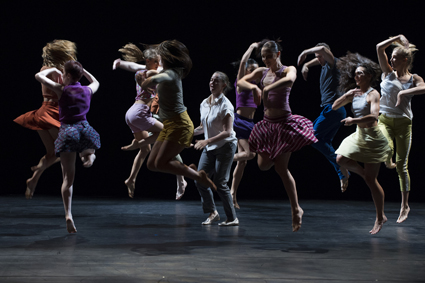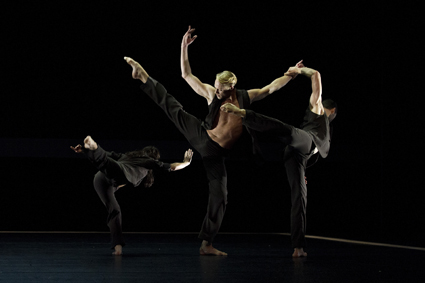Enter the real world
Erin Brannigan: Sydney Dance Company, Interplay

L’Chaim, Interplay, Sydney Dance Company
photo Wendell Teodoro
L’Chaim, Interplay, Sydney Dance Company
The demands of producing new work every year are enough to see off some excellent artistic directors and the addition of a curatorial role assumes skills that some take decades to attain. While Rafael Bonachela has brought us some excellent international choreographers in his mixed bills (Emmanuel Gat, Jacopo Godani) and supports local choreographers intermittently (Adam Linder, Gideon Obarzanek), I have to confess that I’m not sure where he is heading with his programming for Sydney Dance Company.
The gearshift from the lyrical contemporary of Bonachela’s 2 in D Minor to Jacopo Godani’s hard-hitting, ballet-derived Raw Models was manageable and illuminating. Both ‘mickey-moused’ the scores despite the radical difference in their aesthetics. The former was set to Bach’s Partita in D minor for solo violin interspersed with “static sound sculptures” by Nick Wales, and the latter to the aggressively synthetic sounds of German duo 48Nord. Both illustrated the limits of shadowing the score, which becomes a kind of monotony amongst constant variation.
Bonachela’s work provides the sustained note across all of the Sydney Dance Company’s programming, clearly linking with Graeme Murphy’s aesthetic legacy and the big balletic-contemporary companies that operate in a rarefied field that is relatively unchanging. 2 in D Minor featured Bonachela’s signature fluid and non-stop movement, slipping across solos, duets, male/male/female trios and ending in the anticipated unison section. The more filigreed, baroque details of Cass Mortimer Eipper, particularly in his delicate duets with David Mack, were quiet, considered moments amid the din. Violinist Veronique Serret’s onstage performance was phenomenal—five movements and five moods on a searing instrument. Her physical presence and movements in the service of the music often drew my attention away from the dancers.

2 in D Minor, Interplay 2, Sydney Dance Company
photo Wendell Teodoro
2 in D Minor, Interplay 2, Sydney Dance Company
As the new head of The Forsythe Company, we could look at Godani’s commission (first performed by the company in 2011; see interview RT101 online) for the company with new eyes, drawing a straight line to the William Forsythe aesthetic that he will be charged with maintaining. This work looked different to me this time around. I had remembered something very cool, almost frosty, structured around a stop-start rhythm and moving boldly and suddenly to the floor where a darker energy dominated. This time around, the links to an almost Fosse-esque jazz aesthetic were startling. Bob Fosse’s jazz legacy is pervasive, and with a strategically placed group of So You Think You Can Dance finalists in the first row of the Sydney Theatre, the comparison seemed pronounced. The breathtaking virtuosity of some extraordinary dancers was also not lost on this section of the audience who gasped and oohed throughout.
Charmene Yap is clearly the star of this company and a stand-out across all of the works. Her technical prowess is subsumed in the service of finely wrought qualities of movement—often smooth, low and extended—and a presence that is realised through the same, not distracted by the choreography. Her duet with Andrew Crawford—with her tiny frame moving like a shadow around the tall, blonde dancer—was a high point in a piece pitched toward a succession of high points.
The gearshift from Godani to Obarzanek’s L’Chaim (interview, RT119) was a very different experience. The latter’s intention was clearly to break through in two ways: through the façade of physical perfection and choreographic wizardry to the dancers as everyday people, and into the audience where he placed one of his performers. Zoe Coombs Marr (of Sydney-based performance group post) was our proxy in the piece, asking some sensible questions like: “What do you think about when you’re dancing?” “How many years do you have left?” “What do you call specific movements?” Her interrogatory tone grates with the dancers until she breaks down and is asked to join them on stage. This results in a quite spectacular musical number which is what Zoe had asked for, linking the piece back to Obarzanek’s production for Chunky Move, Australia’s Most Wanted where he surveyed audiences nationwide about what they’d like to see in a dance, and also I Want to Dance Better at Parties another work exploring the relationship of the non-dancer to dance.
It’s great to see Gideon Obarzanek pursuing these analytical, accessible and quite political paths of artistic enquiry. The subversive critique of what had come before could not have been lost on audiences either. The real world had entered the theatre, and the paradigm had shifted from a display of performative and choreographic skills to the actual situation we were all engaging in. If it didn’t completely succeed (the end came so quickly and unexpectedly and some of the dancers seemed to miss the spirit of the work), what it was attempting to do was exciting and provocative in this context.
–
Sydney Dance Company: Interplay, Rafael Bonachela, 2 in D Minor; Jacopo Godani, Raw Models; Gideon Obarzanek, L’Chaim; Sydney Theatre, 15 March-5 April; Canberra Theatre Centre, 10–12 April: Southbank Theatre, Melbourne, 30 April-10 May
RealTime issue #120 April-May 2014 pg. 33






